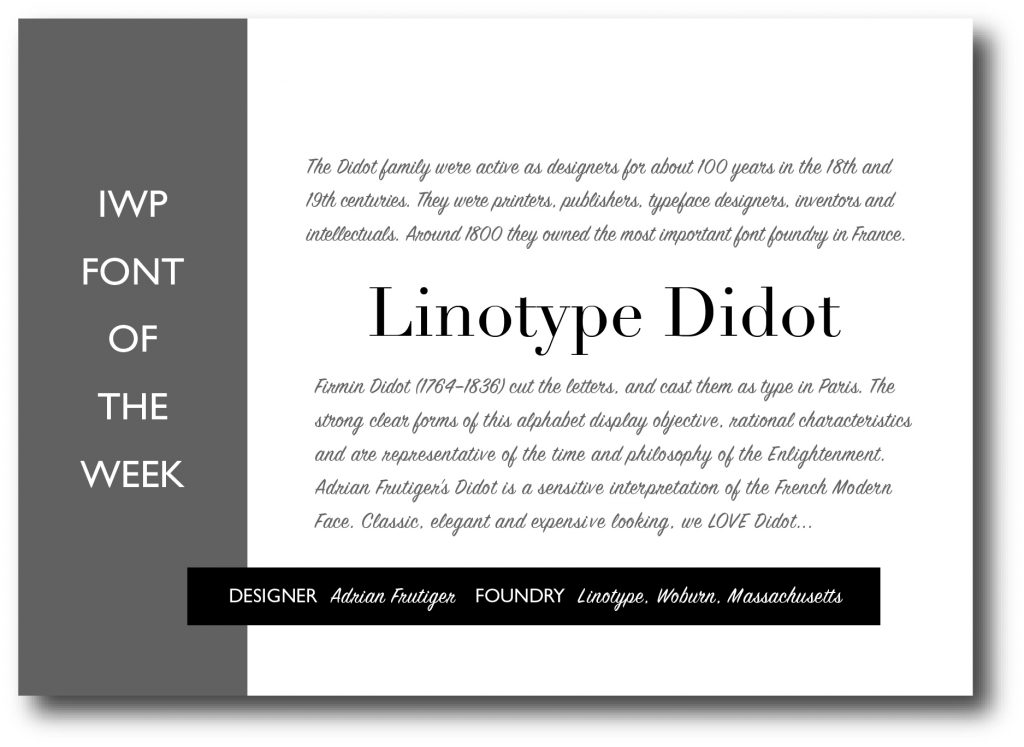
Sometimes the best design simply pops up without the help of a focus group…

Sometimes the best design simply pops up without the help of a focus group…

…and we have a whole drawer full of clever, hardworking ideas, just waiting to be put to use by you, lovely people.
Got a project? Need a refresh? Just want to talk?
We have some of the best eyes (and ears) in the business.
Call Steve, on 07711 143795.
…Sweet.

Furniture advertising and design is what we do. Likewise location and studio shoots, large scale office furniture, kitchen and bathroom sets. One off product shots. Brochure design and printing. IWP love it all.
We’ve planned, designed and produced all of the above, for clients large, small – and startups. Always cost effective, certainly coming up with creative solutions to budget/timing constraints, we love making our clients job look the business.
From original design, planning and production of brochures and online, to managing thousands of price changes, we take it all in our stride – above all, we manage it without any fuss. Consequently we seem to enjoy repeat business as a result.
Talk to us about your next project or even idea – you’ll find we’re not just part of the furniture.
Classic, elegant and expensive looking…
This is what lovely Wikipedia has to say…
Didot is a group of typefaces named after the famous French printing and type producing Didot family.[1] The classification is known as modern, or Didone.
Didot’s type in the Code civil des Français, printed by the company of Firmin Didot in 1804.
The most famous Didot typefaces were developed in the period 1784–1811. Firmin Didot (1764–1836) cut the letters, and cast them as type in Paris. His brother, Pierre Didot (1760–1853) used the types in printing. His edition of La Henriade by Voltaire in 1818 is considered his masterwork. The typeface takes inspiration from John Baskerville’s experimentation with increasing stroke contrast and a more condensed armature. The Didot family’s development of a high contrast typeface with an increased stress is contemporary to similar faces developed by Giambattista Bodoni in Italy.
Didot is described as neoclassical, and evocative of the Age of Enlightenment. The Didot family were among the first to set up a printing press in the newly independent Greece, and typefaces in the style of Didot have remained popular in Greek since.
The Style Network used a bold weight of Didot in its on-air identity (in addition to the News Gothic font). Alexey Brodovitch implemented the usage of Didot in Cahiers d’Art and Harper’s Bazaar. Vogue has been using Didot as the typeface for their cover title since 1955.
A survey of 368 people done by writer and typographer Sarah Hyndman suggested that bold typefaces with rounder terminals appear cheaper, whereas lighter weights, serifs, and contrasts were rated as more expensive, with the modern Didot selected as the most expensive looking font.
The “CBS Didot” version of Didot was commissioned and used by broadcast network CBS for many years alongside its famous “eye” logo. While the network’s use of Didot with its logo is not as prevalent as it once was, it is still a common sight, used mainly for the imaging of CBS News, the logo for CBS Corporation, and the logotype for The Late Show with Stephen Colbert. It is also used as the logotype for the credits of the CBS sitcom “Mom.”
We LOVE how a font can work to deliver creative. So we thought we’d share the love… The right font can help deliver quality and character before a word has been read. Why not see what we can do for you?
Power of fonts harnessed by IWP
From a quick refresh to a hard-working, fully loaded digital campaign. We’ve got the moves… and the fonts…

The last few years has seen beer lovers rejoicing at the surge in the production of craft beer in the UK and the seemingly unstoppable rise of the independent brewer – and if we look at what’s happening in the US beer market as a guide to what might happen in this country, there’s the potential for further growth. The global giants haven’t been resting on their laurels though – they were caught off-guard at first by the craft beer revolution, but quietly and stealthily, they’ve started to react. So what does 2016 have in store for the UK craft beer market? Here are some predictions from us…
Lager renaissance
Sales of the typical cheap, bland lagers have been in decline as drinkers turn to craft brews, the majority of which are ales and bitters. That doesn’t mean to say that lager is down and out though – lager sales still heavily outweigh those of ales and dozens of craft lagers have launched recently as brewers seek to redefine the much maligned beer style. We are expecting to see further craft lagers launched in 2016 as brewers look to capitalise on an upturn in popularity.
More acquisitions by the big brewers
Skyrocketing sales of craft beer have resulted in big brand beers flatlining, and it’s obvious that the big brewers weren’t going to stand idly by and watch. First there was SABMiller’s acquisition of Meantime, then AB InBev’s purchase of Camden and in the US, Constellation’s takeover of Ballast Point.
Craft beer enthusiasts have been crying foul and some have rounded on Camden for “selling out” but from our point of view, it’s an entirely understandable business decision, and I wonder how many other craft brewers would stick to their guns if the opportunity came their way?We do have concerns though – if we look at the US market where the global players have bought stakes in a large number of craft brewers, there have been many cases of costs being cut and quality suffering as a result. And, of course, the big brewers will be able to sell their newly acquired craft beers at a price point that independent brewers can’t match, meaning that many craft brewers might find themselves being driven off the shelf.
We expect to see more craft brewers being bought out in 2016 as the other major brewers turn their eyes to the UK market.
More craft offerings from the big and regional brewers
In contrast to the likes of ABInBev, Diageo have responded to the rising tide of craft beer by launching “The Brewer’s Project” – an experimental brewery that has so far come up with 4 very creditable craft style beers.
Adnams have been expanding their crafty feeling “Jack Brand” range of beers over the past couple of years, Shepherd Neame revived the Faversham Steam Brewery identity for their Whitstable Bay range of beers and Fuller’s have their Frontier small batch craft lager, Montana Red ale and Wild River Pacific pale ale.
With their established brands to fall back on, regional brewers are perhaps able to take more of a risk on something that might not work out, so we predict that 2016 will see more of these sorts of exciting and interesting beers launching onto the market as other regional brewers look to break into the craft beer market.
Experimental beers from small, traditional brewers
Following on from the previous point, we’ve recently spoken to a couple of small, local brewers who are working on their own experimental beer departments for 2016. They wouldn’t necessarily identify themselves as craft brewers, but they’ve been watching what’s going on in the craft segment with growing interest. They are planning to produce small-batch brews of something a little bit more adventurous, without jeopardising the production of their traditional beers.
Cans vs bottles
Canned beer has always been seen as the poor relation to bottled beer, but that’s been more to do with the quality of the liquid put in the can more than anything else – bland and insipid lager is going to taste bad whatever container you drink it out of!
US brewers have been leading the way with cans up until now, but we think 2016 is going to see more UK based craft brewers taking the plunge. When you look at the logic, it’s a no-brainer – it’s clear that sunlight degrades the flavour of beer and aluminium cans provide complete protection from UV. Besides, cans are easier to store and transport than bottles and the aluminium in cans can be recycled over and over again. The polymer lining in modern cans also means that the beer is protected from contamination or unwanted flavours.
Modern micro-canning technology makes canning affordable even for small craft beer producers, and there’s even a mobile canning line fitted into the back of a transit van that you can book to come and visit your brewery. From our point of view, cans look great too and provide the designer with a fantastic canvas to work with.
Gluten-free beer
A few years ago, those that suffered from coeliac’s disease and gluten sensitivity had to pretty much give up on the idea of drinking beer given the paucity of gluten-free brews. Now though, there’s a growing range of options such as Celia, Greens gluten free beer and St Peter’s G-free to name but a few, leading the way in showing that gluten-free doesn’t have to mean flavour-free.
In 2016, expect more brewers to produce gluten-free offerings as they realise that there is a whole group of potential customers who aren’t as well catered for as they could be.
And a few we aren’t so sure on
Sharing bottles
Big brand lagers in sharing bottles have been around for years but will we see the trend becoming more commonplace in craft beer this year? The jury seems to be out at the moment – some craft beer retailers we’ve spoken to tell us that they are selling well, whilst others say there’s not much demand. We’ll keep our eye on this one.
Whale testicle beer
We read recently about Toast Ale, a Hackney based brewery making craft beer from surplus bread – a great idea that helps combat food waste and harks back to the oldest surviving beer recipes from 4000 years ago, but it was another recent beer related story that really made us do a double take: Hvalur 2 is a 5.1% ABV beer from Icelandic Stedji microbrewery that’s made from water, special berry hops and two types of malt and the crowning glory of a single whale testicle in each brewing cycle, weighing between seven and eight kilogrammes.
Personally, we prefer our whales alive and swimming in the sea – each to their own and everything but we’ll stick to our whale-free beers thanks.
So that’s our take on craft beer trends for 2016 – it will be interesting to see how things develop and how many of these come to pass. From our point of view though, just as important as the actual beer itself is the brand – the number of breweries and the volume of beer being produced is increasing at a much greater rate than the available shelf space and the number of venues selling it. It’s absolutely crucial for breweries of all sizes, from the smallest microbreweries right up the biggest conglomerates to continually invest in developing brands that set them apart and help them stand out in what promises to be an ever more competitive year.
In an ever more congested market, it’s essential for craft brewers to develop strong, original brands
Craft beer is one of the fastest growing segments in the UK food and drink industry with over 600 new breweries opening since 2013, driven by budding consumer demand for something more flavoursome and exciting than the usual mass produced offerings from the big breweries. Sparked by the recession, the craft beer revolution has seen the emergence of a new generation of young brewers re-inventing beer as we know it with an incredible variety of weird and wonderful flavours, styles and brands.
Standing out from the crowd
When the craft beer boom first started, there was a perception that being passionate about producing exciting and experimental beers would be enough to drive demand, and visual identity was treated as something of an afterthought. In the early days, this wasn’t an issue, given that the only people buying craft beer were the true beer geeks. Now the craft beer drinking demographic is much broader and more varied than ever before.
Alongside this, there’s also a growing threat from the major brewers: many of them are waking up to opportunities created by the craft beer revolution and are starting to respond by buying up craft brewers such as Meantime and Camden, or by launching their own “craft-style” offerings. With their monopoly on shelf space in the major multiples, there’s limited room for smaller labels.
Producing great beer isn’t enough on its own anymore: it’s absolutely essential for craft brewers to embrace high quality, well thought-out and considered brand and packaging design if they want to survive and thrive in the long-term. The design of your labels can be the difference between a consumer picking your beer off the shelf or not.
Top 4 tips for craft beer design
Your design should tell your story instantly
Creativity and innovation is the driving force behind the boom in craft beer, so it makes sense for that to be reflected by the packaging design. A good design team will be able to get under the skin of the business and become ingrained in the culture of the brewery. They will be able to come up with visual cues, unique to your brand that creatively express the character and personality of the brewery, the authenticity, the provenance and the style of the beer. Good design will get your story across to the customer instantly.
The balance between adventure and security
In the craft beer market, there is a level of tension at the point of purchase between adventure and security; by definition, the craft beer drinker wants to try something new and different – dissatisfaction with insipid mass produced beer was the catalyst that sparked the craft beer revolution – but they also want a level of reassurance regarding the quality of the product.
In our view, this is where some craft beer brands fall down – it doesn’t matter how great your beer tastes – if your packaging looks amateurish, it risks raising concerns about quality, especially with customers who are new to the sector. If your packaging is too safe and traditional, you risk being seen as boring and won’t appeal to drinkers who are after a new experience. Just be aware though, if you go too far the other way with a totally wild and off the wall design you might stand out, but it’s not going to do you much good if people don’t already know your brand or if it’s not clear that it’s a beer.
Good design can help you achieve this balance – bold and original labels will set you apart from your competitors and help you stand out on shelf with the reassurance that the beer tastes as great as the label looks.
Think about how it looks from afar
Visual identity needs to communicate from a distance – if your beer is in a bar, chances are that it’s going to be in a fridge behind the bar, and the customer is going to be viewing it from 6 feet away. Your design needs to be eye catching and inviting enough to stand out but clean enough that viewed from a distance, the key information on the label can still be seen. There’s been a move recently away from overly busy beer labels towards those that are cleaner, simpler and easier to read.
In an ever more congested market, it’s essential for craft brewers to develop strong, original brands
More beer is now drunk at home than pubs and bars, so good design is about more than just pump clips and bottles. With the growing popularity of sharing bottles, growlers, and a move to canned beers, your visual identity needs to work across different packaging options. Of course, this is something a good designer will have in mind right from the start.
Conclusion
Obviously the quality of a beer is vital for it to succeed – if it doesn’t taste right, no one is going to want to drink it, but a great beer in poor packaging isn’t going to do very well either. Great design for craft beer brands is essential for their success in an ever more crowded market place – a good design team will take all that is unique about your beer brand and translate this into a distinctive, bold and original visual identity that tells your story and stands you apart from your competitors.
For help with your beer branding challenges contact Steve Whitehouse.
 To compete in markets dominated by big players, small brands need to get their approach just right. They might not have the spending power of the big brands, but even with limited budgets, small brands can make a real impact so long as they have a strong USP, a well-defined niche and maintain a flexible and innovative mindset.
To compete in markets dominated by big players, small brands need to get their approach just right. They might not have the spending power of the big brands, but even with limited budgets, small brands can make a real impact so long as they have a strong USP, a well-defined niche and maintain a flexible and innovative mindset.
By the very nature of small brands, they tend to have less resource and fewer specialist skills in house, so it is also crucial to know what you are missing and surround yourself with trusted advisors in the areas where you need support.
Small brands making waves
The food and drink industry is a good example of a sector where small brands are able to make waves – at this year’s International Food Exhibition, we were impressed by the sheer number of new, slick looking food and drink brands doing some really interesting things. And it’s these small brands that drive the majority of innovation in their categories – they can be much more nimble and faster to market with products that meet changing consumer preferences than their bigger brethren; and when the big brands do try and catch up with their own versions, they often find it difficult grab the customers imagination in the way that smaller companies do.
The beer industry is a case in point – there has been huge growth in the number of small craft breweries over the last few years, stealing market share from the big players with their exciting and flavoursome beers, and we’ve been lucky enough to work with a couple of them recently.
Some of the big brewers have responded to the craft beer revolution with their own “craft-style” offerings but for the most part they have struggled to resonate with the consumer and have been hampered by set ups that aren’t as well tailored to rapid innovation as their smaller competitors.
Consumer focus on authenticity, provenance and quality
Small and innovative food and drink brands and the craft beer revolution both tap into a consumer focus on authenticity, provenance and quality – a consumer trend that one of our long standing clients, MPM Products saw coming back in 2006 when they launched Applaws – a cat food designed to appeal to the quality conscious consumer who cares what they feed to their animals, made with 100% natural ingredients and no artificial additives.
Since we started working with them on the initial brand identity and launch of Applaws, MPM Products have grown, with our help, from a turnover of £300K and two members of staff to sales of over £30m with their products being stocked by Sainsbury’s, Tesco, Asda, Morrisons, Waitrose, Ocado, Pets at Home and Amazon and sales in Italy, Australia, The US, China and 28 other countries around the world.
The secret of their success has been a focus on constant NPD, product extension and innovation, and investment in brand, packaging design and a customer acquisition strategy that have helped them stand out on crowded shelves and win market share from more well established competitors.
Over the past 9 years we have helped them launch the world’s first 80% protein dry cat food, develop a range of cat and dog food designed specifically for the grocery market and develop two major product innovations – the world’s first see-through pet food pouch that shows the consumer the quality of the food inside, and a simple and convenient re-sealable easy pour jug-bag for cat litter.
For more details on our work with MPM, click here.
MPM might still be a relatively small player compared to the likes of Purina and Mars Petcare, but they have come a long way – from start-up to turnover in the tens of millions in only 9 years, stealing market share from much bigger brands and establishing themselves in a very crowded market – a true David vs Goliath story.
Conclusions
There is a great opportunity for small brands to succeed in sectors dominated by much larger competitors provided they have a strong USP, focus on delivering what the consumer actually wants and surround themselves with people who can help fill their skill gaps. If you want advice on how best to apportion small budgets to deliver branding, packaging design, advertising and an effective growth strategy that delivers real ROI, give us a call!
Craft brewers are the exciting young rebels of the beer industry, but in fact some of their rebelliousness could be misplaced when it comes to their visual identity and packaging design.
When craft producers were just starting to emerge, overt marketing was seen as something that was only done by the major brewers – rebelling against this, a quirky, amateurish visual identity helped craft brewers distinguish themselves from the big brands.
The problem is, the world has changed; the craft beer drinking demographic is broader and more varied – it’s no longer the sole preserve of beer geeks.
Some craft brewers have seen this change in their consumers and have started to do something about it, and there are some fantastic examples of exciting, unique but professional looking visual identities out there – but too many producers still think that being passionate about making exciting and experimental beers is enough on its own to drive demand, and that’s simply not the case any more.
By treating their visual identity as an afterthought or by persevering with deliberately amateurish “anti-brand” packaging design, craft brewers could be playing straight into the majors hands – it doesn’t suit the large brewers to have a craft industry that actually starts to create important brands, brands with good tasting product, in cool interesting packs, that actually sell and meet customer’s needs. Of course it doesn’t – that would mean that the big corporations would actually have to do something about their own products to regain the initiative.
So if the craft industry keeps making fantastic beer but for the most part clothing it in poorly designed packaging the majors are quite happy. But just think if more of the new players start to put their great, innovative beer in desirable, well thought-out and properly designed packaging; sales will snowball, and then what?
IWP Communication is an ex-Saatchi Manchester Design and Marketing agency specialising in food and drink, passionate about serving up hard working, great looking work that helps your business engage with consumers, leading to a bigger slice of the market.